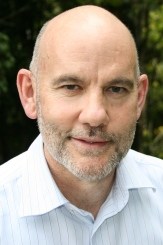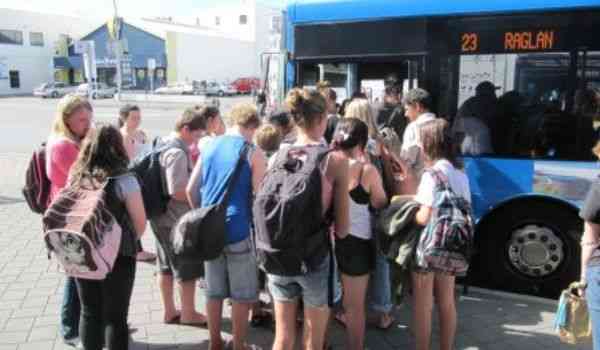Raglan’s WRC councillor, Fred Lichtwark, has succeeded in getting the secretive Waikato Regional Council to at last provide answers to questions on the Raglan 23 bus service. And strange as it seems, WRC may be planning to reduce the number of passenger seats on their Hamilton to Raglan 23 service.

Mike Garrett at WRC- Responsible for Public Transport | Facilities and Property | Finance and Procurement
Mike Garratt, CFO of the WRC provided this information on the types of buses proposed for April 2017:
How many seats will be on each of the 3 new buses?
“Two buses have 49 seats, total capacity including standing passenger is 79 per bus.
The third bus has 43 seats, total capacity including standing passengers is 64.”
To what extent that will solve the overcrowding problem?
“The combined seated capacity of these buses is 141, a 15% increase on current seated capacity. The additional seated capacity is provided by the third bus (currently planned to be used on the Whatawhata – Hamilton service,) and can be extended to/from Raglan if required.
There is expected to be sufficient capacity to meet demand and accommodate growth in the short term. We believe the Raglan service has strong potential for growth, and our intention is to encourage and facilitate this in a manner that doesn’t require passengers to stand for long distances.”
Raglan Bus guru John Lawson said, “I think the current Raglan buses are 51 seaters, so the new buses will seat 2 fewer passengers. In the last year even those larger buses have been full to capacity on 22 occasions. The Whatawhata bus is being increased from 18 to 43 seats, but my observation is that that isn’t the overcrowded bus; I’ve never seen even one person standing on it. Therefore it appears the problem could only be solved with these 3 buses by running all of them through to Raglan. The reply says that no such extension is planned; simply that the 43 seater is ‘currently planned to be used on the Whatawhata – Hamilton service’. So they don’t seem to have a plan on solving the overcrowding and future growth problems.”
On the question of how staff plan to get feedback on the proposed bus services, Mr Garratt said:
“We will have a survey available online and via a printed flyer. The printed flyer will be distributed on the bus and available at the Transport Centre, Hamilton and Raglan libraries and i-SITEs. The Raglan Community Board has also offered to distribute the flyer for us within the Raglan community so we will provide printed copies to them as well.
We’re really keen to get widespread feedback so will also be promoting the survey via:
- Facebook (geotargeted to Hamilton and Raglan users)
- Bus posters on all Hamilton and Raglan buses as well as at the Transport Centre
- A large scale (2400mm x 1200mm) sign at the Transport Centre
- Paid advertisement in the Raglan Chronicle
- Information on the front page of both the mobile and desktop versions of www.busit.co.nz
When asked about how WRC staff plan to get feedback on the proposed bus services, Mr Garratt said:
What has been done to implement Recommendation 27 of Regional Energy Strategy
(https://www.waikatoregion.govt.nz/assets/PageFiles/13327/Waikato%20regional%20energy%20strategy.pdf), in particular “encouraging mode choices including public transport, walking and cycling”
Recommendation 27 states: Promote reduced transport energy consumption and encourage energy and transport efficiency such as for moving of freight and encouraging mode choices including public transport, walking and cycling.
Who needs to take these steps
Environment Waikato and local councils, town planners, architects, developers, Ministry of Transport, Waikato University and Wintec, Waikato Regional Energy Forum (as advocate)
What action is required
- Promote sustainable energy efficient urban design and development.
- Promote the development of electric vehicles such as the Waikato University work on electric car technology.
Where should actions be focused
- promotion of education events and workshops that encourage energy efficient travel
- promotion of sustainable urban design and growth strategies that encourage ‘green’ travel options and reduce the need for travel
When should the steps be taken
Within the next 12 months
WRC has been actively involved in implementation of recommendation 27. In particular the 2015 Regional land Transport Plan and 2015 Regional Public Transport Plan have sections in them outlining the policy and actions WRC is taking to promote reduced energy consumption from the Transport Sector and also encouraging energy efficiency in the transport sector. Links to these documents can be found at:
https://www.waikatoregion.govt.nz/Council/Policy-and-plans/Transport-policy/RLTP/
In addition WRC has been actively engaging with regional stakeholders to develop a Regional Cycling programme Business case and a Regional Access and Mobility programme business Case. These two PBCs are nearing completion and will be available for circulation early in the new year.
Other activities undertaken are the development of the RPS (Built Environment Chapter) which outlines settlement patterns and growth in the region.
https://www.waikatoregion.govt.nz/council/policy-and-plans/regional-policy-statement/
WRC is also an active partner in Future Proof which is the central Waikato growth strategy.
WRC is taking an active interest in electric vehicles and will be shortly introducing a fully electric vehicle (e Golf) into its fleet as well as two new hybrid vehicles. WRC keeps in close touch with the Ministry of transport on latest developments in electric vehicles and national policy.

